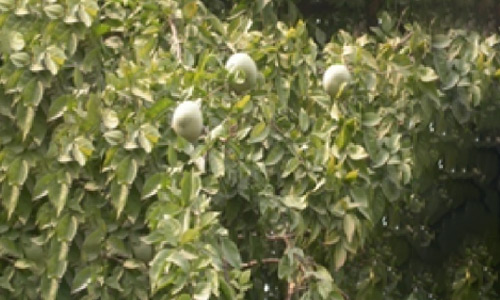|
Division
|
Angiosperms |
|
Class
|
Dicotledons |
|
Subclass |
Polypetalae |
|
Series |
Disciflorae |
|
Order |
Geraniales |
|
Family
|
Rutaceae |
|
Genus
|
Aegle |
|
Species
|
marmelos |

|
Etymology: |
In Greek mythology Aegle one of the water nymphs who presided over rivers and springs. |
|
Botanical name
|
Aegle marmelos (Linn.) Corrêa |
|
Local/Trade names:
|
Bael, Golden Apple, Stone Apple, Indian Quince |
|
Conservation status:
|
Commonly cultivated. |
|
Digonestic features: |
Branches with spines; leaflets trifoliate. |
|
Description: |
A moderate-sized tree, 6-8 m high; branches with long spines. Bark grey, corky. Leaves trifoliolate; leaflets 4-7 x 2-4 cm, lanceolate or elliptic. Flowers ca 2.5 cm in diameter, greenish-white, sweet-scented. Fruit ca 5-10 cm indiameter, globose, rind woody. Seeds embedded in orange-coloured sweet pulp. |
|
Phenology: |
Fls.: May-June. Frts.: May-June. |
|
Distribution:
|
Throughout the India. Myanmar and Sri Lanka. |
|
Where to see it: |
Ornamental Garden, Nutritive Garden and Gate No. 2 side. |
|
Uses: |
Unripe or half rip fruits astringent, digestive, and stomachic, used for diarrhoea and dysentery. Pulp aromatic and cooling, used in the form of sherbet. Marmelosin is the active constituent; it acts as a laxative and diuretic, in strong doses a caridiac depressant. Gummy substance around the seeds serves as an adhesive, more abundant in young fruits. Also used as a varnish for pictures and adds brilliancy to water-colour paints. Dried fruits, freed from pulp, are used as pill-boxes. Stem yields a gum. Leaves contain an essential oil. |
Chief Conservator of Forests & Chief Wildlife Warden is the Head of the Department. There is one post of Conservator of Forests & two posts of Deputy Conservator of Forests viz.